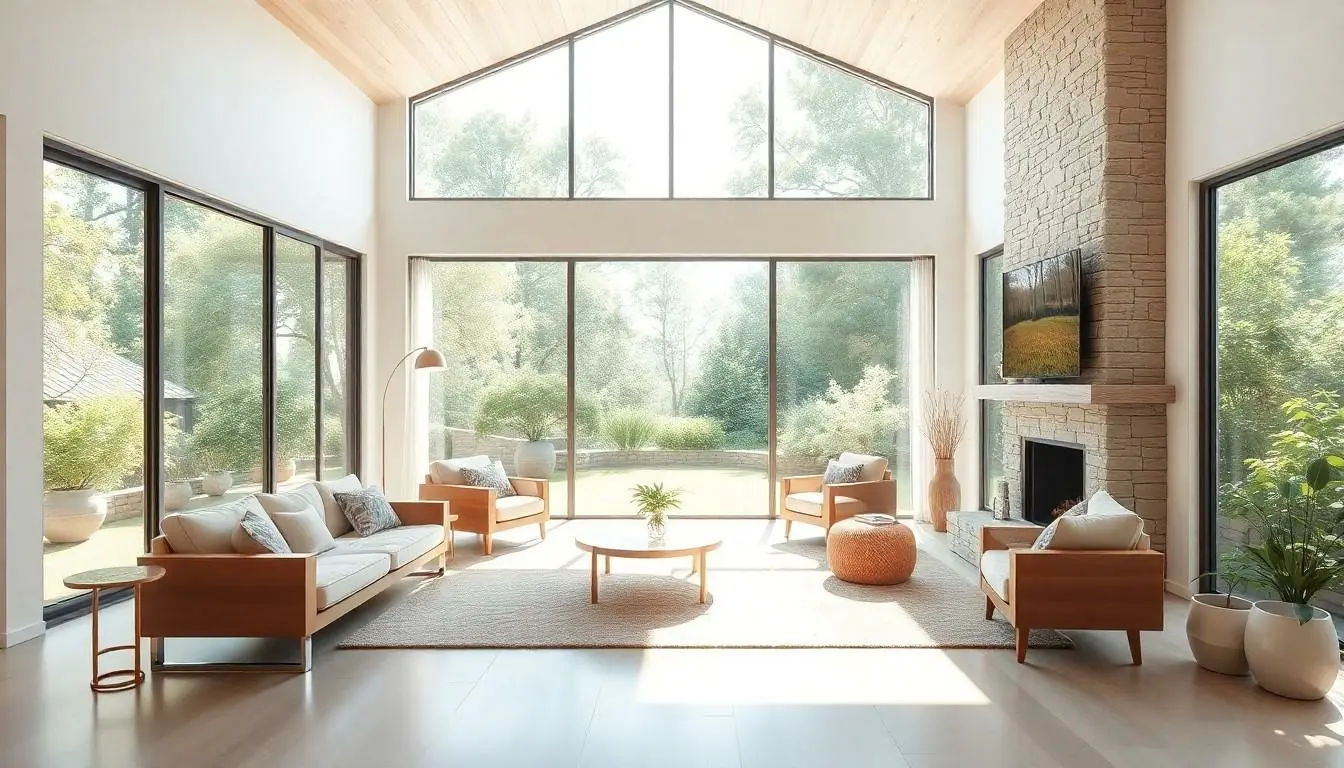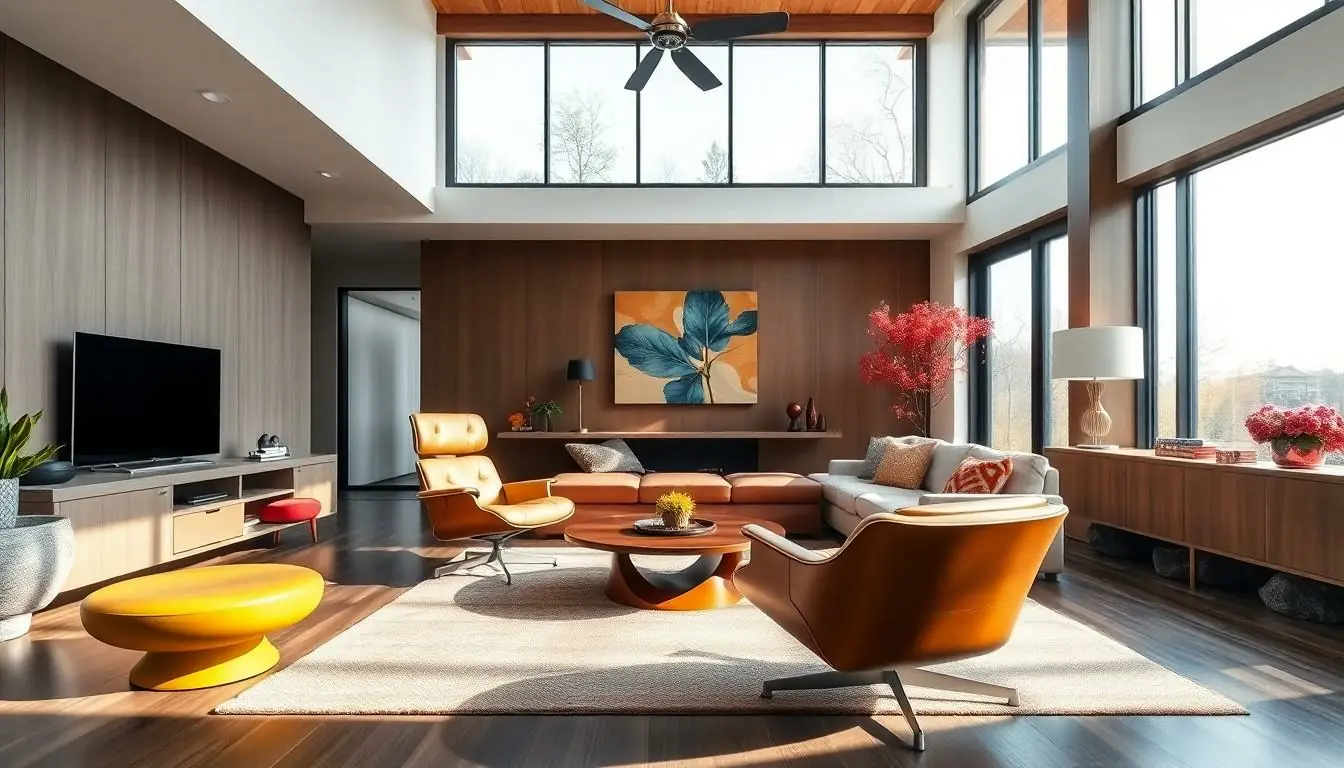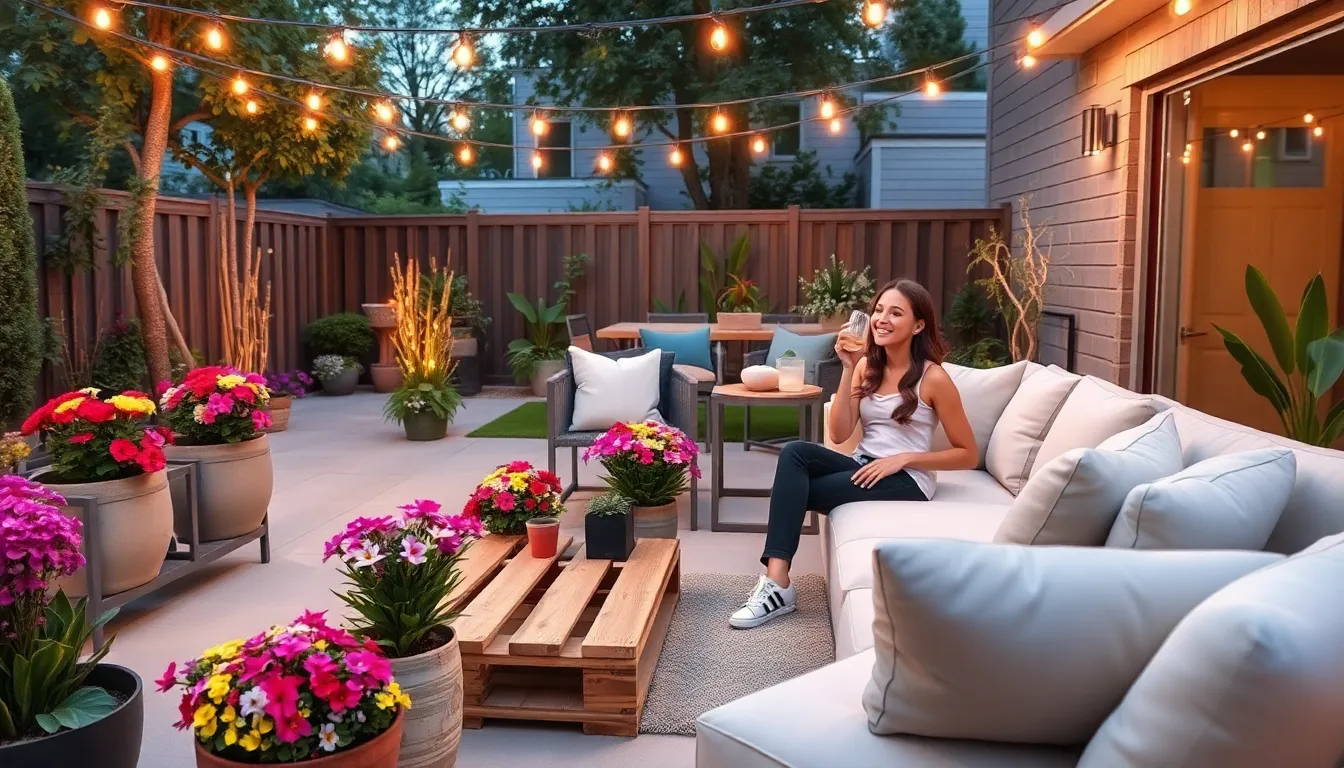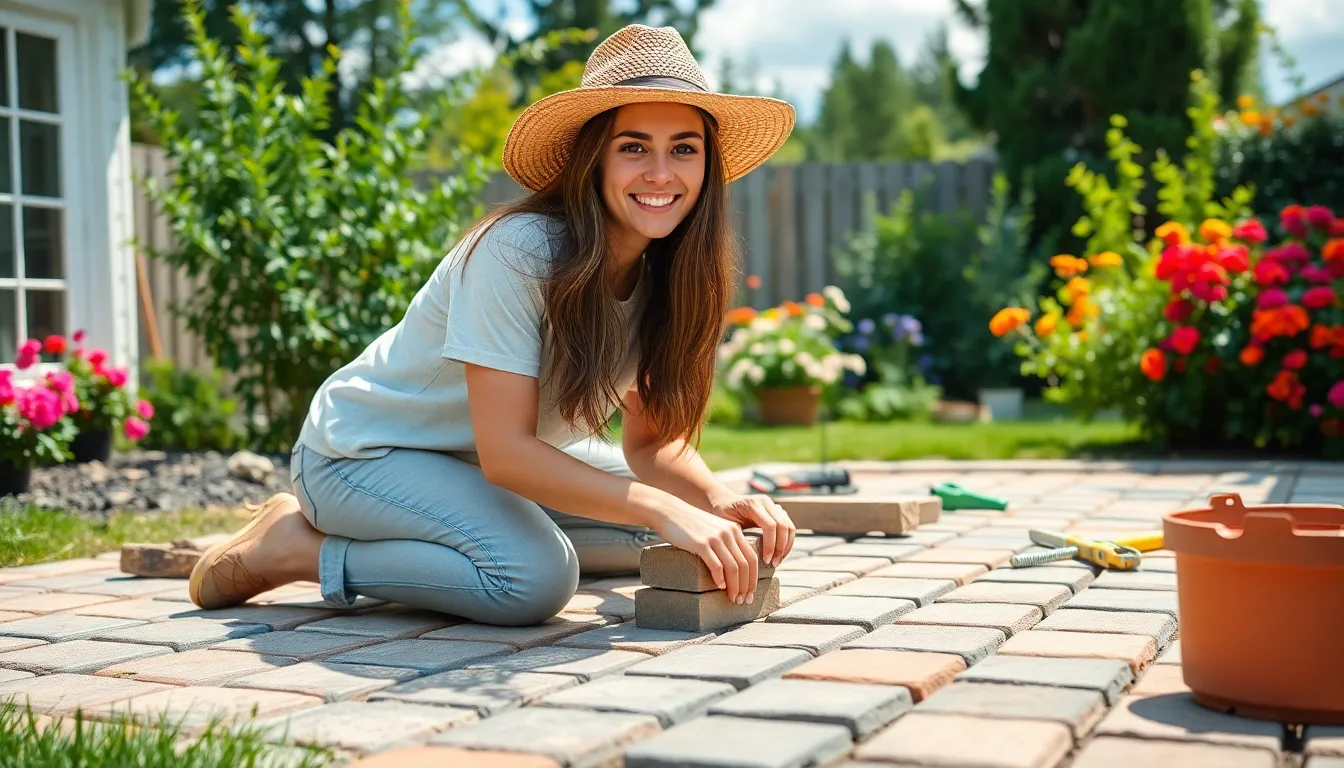Mid-century modern home design isn’t just a style; it’s a lifestyle that brings a splash of retro charm to today’s world. Imagine sleek lines, organic shapes, and a color palette that makes your heart sing. This design movement, which flourished from the 1940s to the 1960s, is like that cool uncle who always knows how to throw a party—effortlessly stylish and eternally relevant.
Table of Contents
ToggleOverview of Mid Century Modern Home Design
Mid-century modern home design stands out with its unique aesthetic and functional simplicity. Characterized by clean lines, this design movement emphasizes an organic connection between the indoor and outdoor spaces. Designers often used large windows to create a seamless flow, allowing natural light to enhance interiors.
Vibrant color palettes are fundamental to mid-century modern homes. Expect to find lively hues combined with neutral tones, creating a balanced yet energizing atmosphere. Iconic furniture pieces, such as the Eames lounge chair, exemplify the style’s commitment to both form and function.
Architectural elements provide a distinct identity in mid-century modern homes. Flat planes and open spaces define their structure, while integration of nature remains essential. Use of natural materials, including wood and stone, strengthens this connection, fostering a sense of warmth and comfort.
This design movement also embraces minimalism, prioritizing essential furniture and decor. Clutter-free spaces enhance aesthetics, allowing individual pieces to shine. Fans of the style appreciate its focus on simplicity, which encourages both relaxation and sociability.
Cohesiveness plays a vital role in mid-century modern designs. Room layouts often feature multi-functional areas that support modern living. Creating inviting spaces that encourage interaction remains at the forefront of this design philosophy.
Integrated technology complements these homes. Built-in appliances and innovative features reflect contemporary needs, demonstrating that mid-century modern design incorporates practicality without sacrificing style. This harmonious blend positions mid-century modern as a lasting, influential choice in home design.
Key Characteristics

Mid-century modern home design showcases distinct features that emphasize simplicity and functionality. This design movement creates inviting spaces through its unique elements.
Open Floor Plans
Open floor plans encourage a seamless flow between living areas. These layouts enhance social interaction while maximizing natural light. Rooms merge into one another, creating a spacious feel without barriers. Furniture placement often defines different zones, allowing for versatile use of spaces. Designers incorporate minimal walls to maintain an airy atmosphere, promoting a sense of freedom and connection within the home.
Use of Natural Materials
Natural materials play a significant role in mid-century modern design. Wood, stone, and glass create warmth and a tactile quality throughout interiors. Often, designers choose locally sourced materials to enhance sustainability. Textures vary from smooth finishes to rugged surfaces, adding depth to rooms. Furniture pieces showcase natural grain patterns, highlighting craftsmanship and authenticity. This emphasis on organic materials fosters a sense of calm and grounding within the home.
Integration with Nature
Integration with nature is a hallmark of this design style. Large windows, sliding doors, and glass walls invite the outdoors inside. Views of gardens or landscapes enhance tranquility and inspire a connection to the environment. Outdoor spaces often blend seamlessly with interiors, encouraging outdoor living. Landscaped areas become extensions of the home, fostering a peaceful coexistence with nature. This focus on natural elements reinforces mid-century modern design’s commitment to harmony and balance.
Famous Designers and Architects
Mid-century modern design boasts several influential designers and architects, each contributing uniquely to its evolution. Their innovative approaches shaped this distinctive style.
Charles and Ray Eames
Charles and Ray Eames played a pivotal role in mid-century modern design through their furniture and architecture. They crafted iconic pieces like the Eames lounge chair, blending comfort with elegance. Their experimentation with materials such as molded plywood and fiberglass revolutionized furniture design. The duo embraced modularity in their designs, making stylish yet functional items accessible to a broader audience. Their contributions extended beyond furniture; they explored architecture and industrial design, cementing their legacy in American design.
Frank Lloyd Wright
Frank Lloyd Wright significantly influenced mid-century modern architecture by emphasizing harmony between structures and their surroundings. His concept of organic architecture promoted designs that integrated natural elements, creating seamless indoor-outdoor connections. Notable works, such as the Fallingwater residence, showcase his innovative use of cantilevered structures and natural materials. Wright’s open floor plans encouraged fluid space utilization, enhancing social interaction within homes. His commitment to bringing nature indoors resonated throughout the movement, impacting countless architects and designers who followed.
Popular Mid Century Modern Home Features
Mid-century modern design features a range of distinctive elements that create its unique charm and appeal. These characteristics blend style with functionality seamlessly.
Iconic Furniture
Iconic furniture pieces play a crucial role in mid-century modern homes. Designers like Charles and Ray Eames contributed timeless items such as the Eames lounge chair, known for its comfort and sleek design. The Noguchi coffee table showcases an organic shape that complements any space beautifully. Other notable pieces include the Tulip table by Eero Saarinen, which combines a minimalist aesthetic with innovative engineering. Each of these furnishings emphasizes form and function while serving as focal points in living areas.
Color Palettes
Color palettes in mid-century modern homes exhibit boldness and vibrancy. Bright colors often contrast with neutral tones, enhancing visual interest in any room. Shades of mustard yellow, avocado green, and burnt orange frequently create a lively atmosphere. Earthy tones like browns and beiges complement these hues, providing balance and warmth. These palettes extend beyond walls, influencing furniture and decor choices. Homeowners embrace these combinations, ensuring a cohesive and inviting environment.
Lines and Shapes
Lines and shapes define the overall aesthetic of mid-century modern architecture. Clean lines and geometric shapes dominate the design, promoting a sense of openness and simplicity. Flat planes, particularly in roofs and furniture, contribute to a streamlined appearance. Organic shapes, such as rounded edges on chairs and tables, introduce a softer touch that contrasts with linear elements. This balance between sharp and soft lines enhances visual flow within spaces. Architects and designers utilize these principles to create harmonious environments that invite interaction and relaxation.
Tips for Incorporating Mid Century Modern Design Today
Incorporating mid-century modern design into contemporary homes enhances aesthetic appeal and functionality. Here are some practical tips to achieve this look.
Choosing the Right Furniture
Select iconic pieces to anchor the space. Eames lounge chairs, Noguchi coffee tables, and Tulip tables exemplify mid-century modern design while providing comfort and style. Opt for furniture with clean lines and organic shapes, reflecting the simplicity of this design movement. Prioritize functionality by choosing multi-purpose items that promote usability without sacrificing visual interest. Market availability includes many reproductions, allowing easy access to affordable options. Avoid overly ornate designs, as minimalism remains key in achieving the desired mid-century modern aesthetic.
Art and Decor Considerations
Art and decor play vital roles in mid-century modern interiors. Utilize bold, vibrant artwork to create focal points and energize the space. Consider geometric shapes and abstract forms, aligning with the movement’s characteristic design elements. Incorporate decor pieces made from natural materials, such as wood and ceramics, to enhance textures and warmth. Layering textures through various fabrics and materials adds depth and interest. Place strategically chosen accessories to maintain a clutter-free environment, highlighting the importance of curated decor in achieving this timeless style.
Mid-century modern home design remains a celebrated choice for those seeking a balance of style and functionality. Its emphasis on clean lines and organic materials creates inviting spaces that foster connections with nature. The movement’s iconic furniture pieces and vibrant color palettes continue to inspire contemporary interiors, proving that timeless design never goes out of style. By incorporating elements of this aesthetic, homeowners can achieve a harmonious environment that promotes both relaxation and social interaction. Embracing mid-century modern design not only enhances living spaces but also pays homage to a rich architectural legacy that resonates today.





